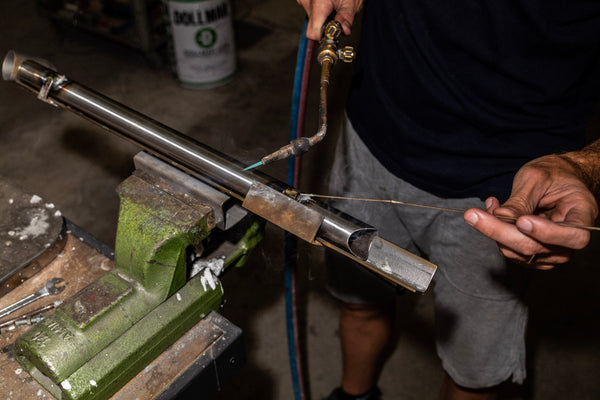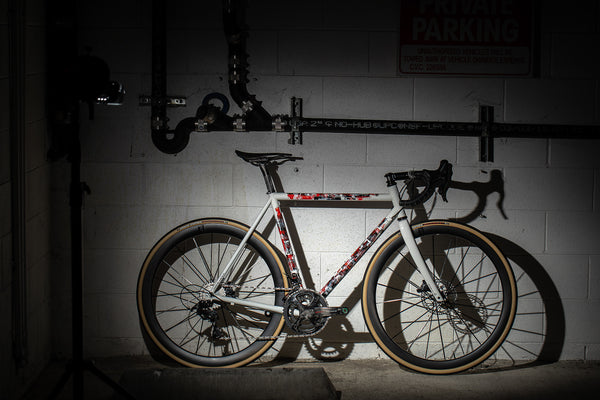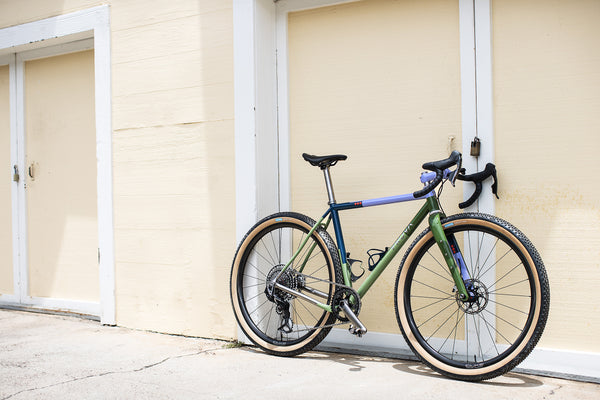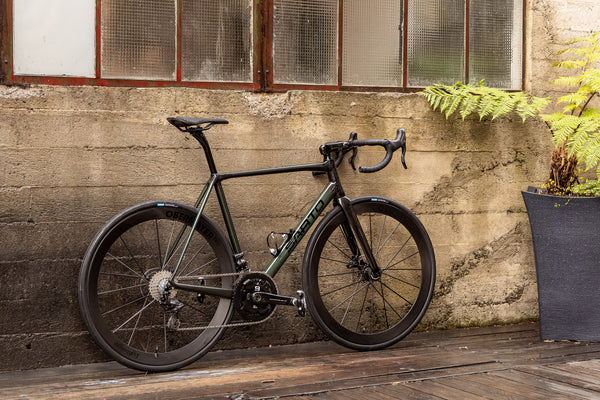AN UNCOMMON UNION
I stepped off the plane into a sweltering Midwestern summer. Madison, Wisconsin is not a place I'd ever thought I'd ever set foot in - willingly. I've arrived in America's Dairyland in the midst of August with much more than a hair's breadth of trepidation. My name is Nate. I work for a premium cycling brand, one built on on an overarching premise of handbuilt, custom, and exclusively performance road bicycles. I am here to meet with Trek Bicycles, one of the world's largest manufacturers of bicycles. From an outside perspective, it's the rough equivalent of Noam Chomsky sitting down with Fox News for an interview to join the network.Madison is smaller than I imagined. It's a university town, situated between two lakes amongst the rolling, forested Wisconsin plains, plains that seem to lope on forever with an easy, relaxed gait. In time, the terrain begins to remind me of Madison's denizes - friendly, warm, unhurried, with a seemingly heightened sense of awareness that buzzes like the Wisconsinan cicadas at twilight. And Trek itself? Not even based here. They're 20 miles out of town, a billion-dollar behemoth in the proximally sleepy burg of Waterloo, which, as it turns out, has a more popular alias for small towns in the Midwest than in Wallonia.


I'm here because of a geometry chart. Sometime in mid-2016, I fixated on one as I'm wont to do. It was only recently after my time with Baum Cycles that I'd become quite keen and opinionated on relatively obscure concepts when it comes to building bikes. Numbers like bottom bracket drop, fork trail, wheelbase, and front-center length. The geometry chart in question belonged to a bike dubbed the Domane Race Shop Limited, a machine not even listed on its progenitor's website. It looked like something that I'd spent countless hours searching for - geometry characteristics dangerously close to my own custom titanium bike - in production carbon. Geometry characteristics that are far beyond the acceptable norms of most mass-market road bicycles.
Unable to find anonymous internet confirmation that the bike in question actually existed, I asked Trek. Was it true? After all, this was no fluke - somebody did this for a reason, and where that reason lay could possibly be an underlying strategy of letting mad scientists have their way with product, where building homologated race cars that only run on 97 octane fuel for everyday use is an okay thing. Confirmation. The bike is real. As the cliché goes, the rest is history, and I found myself on a plane to Wisconsin.


In the domestic cycling industry, Trek is an anachronism. Much like the small and custom builders we work with, almost everything is - or can - be done in-house. Idea. Concept. Design. Prototype. Testing. Production. Painting. In a world where most production bikes are an exercise in badge-engineering, with everything from design to manufacturing completed by a small cabal of overseas composite firms, Trek's modality is absolutely refreshing. Though it's not a simple case of complete control over a finished product, it is complete control over an outstanding product. Even in its infancy, Trek was a pioneer in manufacturing techniques. In this 1978 piece, the iconoclastic (and Marin County neighbor) Gary Fisher describes how Trek innovatively employed automation and new materials to improve both frame quality as well as production speed. In 1990, reinforcing Trek's craving for control over the end result, founder Richard Burke had Trek develop its OCLV carbon manufacturing process in-house instead of outsourcing, turning out their first domestically-produced carbon frameset (and lightest road frame in the world) in 1992. The tradition continues to the present day, a tradition we will admit we were ignorant of. When NASA's space shuttle program ended in the early 2010s, Trek scooped up composites engineering talent normally accustomed to designing multi-billion dollar spacecraft to build bicycles, a tragic twist of modern irony resulting in some of cycling's most highly-engineered carbon bikes to date. Trek is not simply an engineering powerhouse in cycling, it's a respected composites innovator in a much broader sense, a claim no other bike company can possibly make.


Enter Waterloo. It was selected as Trek's front door in 1975 on the basis of being halfway between Milwaukee and Madison, respective homes of Trek's founders, aforementioned Mr. Burke and Bevil Hogg. As far as billion-dollar businesses go, Trek is unassuming, still privately-held, still a mere mile from the venerable red barn where the first steel frames were brazed together in the era of disco and Carter. Inside Trek's walls, however, lies a talented crew of quirky, insatiable, and possibly shut-in bike dorks. For Above Category, the resonance is uncanny. When it comes to our mantra of uncompromising performance, Trek's three road machines are the epitome, all built in what Trek calls "Race Shop Limited" guise in Wisconsin, while their custom Project One paint program satisfies our lust for form married to the highest function. Just as well, these three purpose-built bikes are honed on the WorldTour by Trek's own factory racing team, not simply a team they sponsor. Fun fact: All of TFR's riders are actual employees of Trek, instead of contractors, as is normally the case. Not only does this help with gritty details like health insurance, but also when it comes to actual product development. Trek Factory Racing - and now, Above Category - rides on Trek's three top-flight road bicycles.

MADONE
Named after he-who-must-not-be-named's favorite training climb in the south of France, it's Trek's most striking departure from the traditional round-tube road bike. As the looks let on, it's a pure aero bike, but unlike the rest of the industry's "hyperaero" offerings, it's remarkably good as an everyday all-around road bike, too. By utilizing their deep well of composite engineering expertise, Trek has created not only one of the world's most slippery aero bikes, but also one that's incredibly comfortable and refined thanks to a decoupled seat tube-within-a-seat tube. They call is IsoSpeed. We call it awesome. It's not heavy, either, and while the looks can be somewhat polarizing, amongst the go-fast bikes out there, we're calling it our favorite. Madone could easily take the place of many other brand's standard Grand Tour racer - an impressive feat.
ÉMONDA
Considering Grand Tour race bikes, we think of Émonda to be the modern pinnacle. One of the world's lightest production frames at 690g, its featherweight belies its capability as a bike we'd be happy to line up with at almost any event. Proffering crit bike stiffness, with its razor-edge mannerisms filed down by confident stage racing geometry, it's a downright pleasant bike to ride all day up any rise. Think of it as the immensely versatile weapon of choice when we aren't sure which gun to bring to the knife fight.
DOMANE
Dough-mawn-eh. Meet Trek's secret weapon, the Classics race bike for the ages. Developed over the cobbles of Northern France and Flanders, with input from one-day legend Fabian Cancellara. It’s the third in the quiver of Trek’s pure road racing bicycles, built around IsoSpeed tech at the seat tube and fork steerer. With a decoupled steerer (fore-aft) and seat tube, the parts of the frame both the rider’s hands and rear end are connected to, those parts of the bike, which are designed along the same concept as a carbon leaf spring, flex vertically, giving the rider as smooth of a ride as possible without affecting the rigidity of the frame at all. At the rear of the bike, IsoSpeed on the Domane is adjustable with a slider and 4mm allen key, allowing the rider to tune the ride from rock-solid for glassy tarmac to butter-smooth to attack rough roads. The Domane also proffers enormous amounts of tire clearance, with the rim-brake version easily clearing a 28mm Vittoria Corsa. Trek says the disc version will swallow a 32mm, but we’ve heard rumors of larger. While packed with tech like its aero sibling the Madone, the Domane is not a heavy bike, with frames coming in under 1000g. The Domane is even equipped with hidden fender mounts, making it an ideal winter training bike in poor conditions, especially in disc-brake spec.
Resheathing the marketing speak, we knew what a bombshell working with Trek would be, and did something extreme not only to put the bikes through their paces, but to truly acquaint ourselves with them. We bought one example of each of the above, built them as we saw fit, and then rode them from Los Angeles to San Francisco over some of the most difficult roads we could find, including dirt, 20% gradients, ripping descents, and harrowing windblown flats. 842km and 15,500m in five days (fret not, more on this next week). To say that each performed admirably was an understatement, a testament to the versatility, durability, and performance of what we're calling the most advanced production bikes in the world.

We're ecstatic about our new partnership with Trek, and the unique opportunity we have to exclusively showcase their top-line Race Shop Limited bicycles in Project One livery. Has the torch of passion, technology, and innovation passed from the Old World to the New? Perhaps. Wisconsin doesn't have the Stelvio, the Galibier, Coppi, Anquetil, Ernesto, or Tullio, but there's something going on in Waterloo that seems to have been erased in the European industry by the great shifts in global modes of production and development, something that's been engendered by forty years of the relentless pursuit of progress.
NEXT WEEK: The Escape from LA. Three riders, three bikes, 800+km, and the hardest routes in coastal California.
Start your Build
Since 2006, we've been creating the world's finest dream bikes with our signature approach to custom builds and customer service.
Our Custom Program
AC Everywhere
You can find us just over Golden Gate Bridge in California's Marin County. Can’t come to us? We can bring the bike to you. We craft custom bikes for clients all across the U.S. and the world.
Contact us






Back to Journal